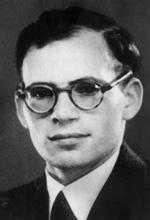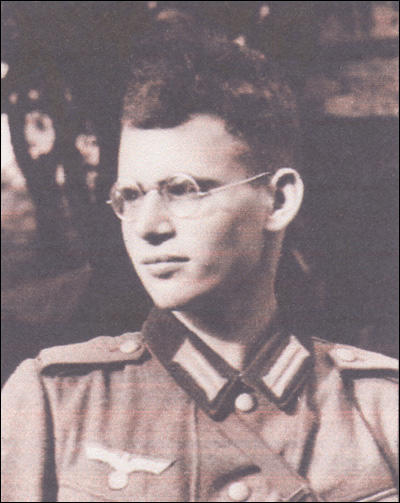Hans Leipelt

Hans Leipelt, the son of Katharina Leipelt and Konrad Leipelt was born in Vienna on 18th July, 1921. His mother came from a Jewish family but she was baptised as a Protestant. His father was Technical Director of Zinnwerke Wilhelmsburg. (1)
Life for the family became very difficult after Adolf Hitler came to power. (2) Under the terms of the Nuremberg Laws Hans and his sister, Maria, were classified as "Jews". It is estimated that over 70,000 Christians in Germany had two Jewish grandparents and now lost their rights as German citizens. (3)
In 1938 Hans Leipelt was conscripted into the German Army. He became a member of the Motorized Infantry Regiment and served in France and Poland, winning the Tank Combat Medal and the Iron Cross II, before being dismissed from the army when they discovered his mother was half-Jewish. (4)
In the autumn of 1940, he began his chemistry studies at the University of Hamburg, but transferred in the 1941-1942 winter semester to the University of Munich, as student of Heinrich Otto Wieland. "He was known as a refuge for opponents and victims of the regime. Again and again the noble and fearless scientist, in contravention of the National Socialist race laws, took non-Aryan students into the institute and thus saved them from forced labour or worse." (5)

It was during this period he began associating with Alexander Schmorell, Hans Scholl, Jürgen Wittenstein, Christoph Probst, Willi Graf. Sophie Scholl, Traute Lafrenz, Lilo Ramdohr and other members of the White Rose group. (6) In January 1943, the group published a leaflet, entitled A Call to All Germans!, It included the following passage: "Germans! Do you and your children want to suffer the same fate that befell the Jews? Do you want to be judged by the same standards as your traducers? Are we do be forever the nation which is hated and rejected by all mankind? No. Dissociate yourselves from National Socialist gangsterism. Prove by your deeds that you think otherwise. A new war of liberation is about to begin." (7)
The Gestapo later estimated that the White Rose group distributed around 10,000 copies of this leaflet. The Leipelt family were involved in distributing the leaflets in Hamburg. (8) The authorities took the fifth leaflet more seriously than the others. One of the Gestapo's most experienced agents, Robert Mohr, was ordered to carry out a full investigation into the group called the "Resistance Movement in Germany". He was told "the leaflets were creating the greatest disturbance at the highest levels of the Party and the State". Mohr was especially concerned by the leaflets simultaneous appearance in widely separated cities. This suggested an organization of considerable size was at work, one with capable leadership and considerable resources. (9)
On 13th January, 1943, the Gauleiter of Bavaria, Paul Giesler, addressed the students of University of Munich in the Main Auditorium of the Deutsche Museum. He argued that universities should not produce students with "twisted intellects" and "falsely clever minds". Giesler went on to state that "real life is transmitted to us only by Adolf Hitler, with his light, joyful and life-affirming teachings!" He went on to attack "well-bred daughters" who were shirking their war duties. Some women in the audience began calling out angry comments. He responded by arguing that "the natural place for a woman is not at the university, but with her family, at the side of her husband." The female students at the university should fulfill their duties as mothers instead of studying. He then added that "for those women students not pretty enough to catch a man, I'd be happy to lend them one of my adjutants". (10)
Traute Lafrenz and Katharina Schüddekopf began shouting abuse at Giesler. Other women in the audience joined in. (11) Giesler then ordered their arrest by his SS guards. Male students, including Hans Leipelt, came to their aid and fights began all over the auditorium. Those who managed to escape ran out of the museum and after forming themselves in a large group, began marching in a procession in the direction of the university. They linked arms as they marched singing songs of solidarity. However, before they got to the university armed police forced them to disperse. (12)
The White Rose group believed there was a direct connection between their leaflets and the student unrest. They decided therefore to print another 1,300 leaflets and to distribute them around the university. On 18th February, 1943, Sophie and Hans Scholl went to the University of Munich with a suitcase packed with leaflets. According to Inge Scholl: "They arrived at the university, and since the lecture rooms were to open in a few minutes, they quickly decided to deposit the leaflets in the corridors. Then they disposed of the remainder by letting the sheets fall from the top level of the staircase down into the entrance hall. Relieved, they were about to go, but a pair of eyes had spotted them. It was as if these eyes (they belonged to the building superintendent) had been detached from the being of their owner and turned into automatic spyglasses of the dictatorship. The doors of the building were immediately locked, and the fate of brother and sister was sealed." (13)
Jakob Schmid, a member of the Nazi Party, saw them at the University of Munich, throwing leaflets from a window of the third floor into the courtyard below. He immediately told the Gestapo and they were both arrested. They were searched and the police found a handwritten draft of another leaflet. This they matched to a letter in Scholl's flat that had been signed by Christoph Probst. Following interrogation, they were all charged with treason. (14)
The authorities arrested and executed the leaders of the White Rose group. Sophie Scholl, Hans Scholl, Christoph Probst, Willi Graf, Alexander Schmorell and Kurt Huber. Hans Leipelt joined forces with Marie-Luise Jahn and continued to distribute White Rose leaflets and collected money for Kurt Huber's family. It was not long before Hans and his mother, Katharina Leipelt, were arrested. Katharina committed suicide on 9th December, 1943. (15)
Hans Leipelt was held in prison for over twelve months before being tried on 13th October, 1944. He was sentenced to death, and three of his seven co-defendants received long prison terms. He was executed on the guillotine on 29th January, 1945. (16)
Primary Sources
(1) White Rose leaflet, A Call to all Germans (January, 1943)
Germans! Do you and your children want to suffer the same fate that befell the Jews? Do you want to be judged by the same standards as your traducers? Are we do be forever the nation which is hated and rejected by all mankind? No. Dissociate yourselves from National Socialist gangsterism. Prove by your deeds that you think otherwise. A new war of liberation is about to begin. The better part of the nation will fight on our side. Cast off the cloak of indifference you have wrapped around you. Make the decision before it is too late! Do not believe the National Socialist propaganda which has driven the fear of Bolshevism into your bones. Do not believe that Germany's welfare is linked to the victory of National Socialism for good or ill. A criminal regime cannot achieve a victory. Separate yourself in time from everything connected with National Socialism. In the aftermath a terrible but just judgment will be meted out to those who stayed in hiding, who were cowardly and hesitant.... Imperialistic designs for power, regardless from which side they come, must be neutralized for all time... All centralized power, like that exercised by the Prussian state in Germany and in Europe, must be eliminated... The coming Germany must be federalistic. The working class must be liberated from its degraded conditions of slavery by a reasonable form of socialism... Freedom of speech, freedom of religion, the protection of individual citizens from the arbitrary will of criminal regimes of violence - these will be the bases of the New Europe.
(2) Inge Scholl, The White Rose: 1942-1943 (1983)
Hans Leipelt had moved from Hamburg to Munich as early as the winter of 1941 in order to continue his studies in chemistry. The Chemical Institute of Munich University, under the direction of Professor Heinrich Wieland, was known as a refuge for opponents and victims of the regime. Again and again this noble and fearless scientist, in contravention of the National Socialist race laws, took "non-Aryan" students into the institute and thus saved them from forced labor or worse.
As far as is known, Leipelt had no direct contact with my brother Hans and sister Sophie, but did know some of their friends in Munich. He can be considered the central link between the Hamburg and the Munich student resistance after the Gestapo seized Traute Lafrenz . In Hamburg, too, the leaflets were distributed, and collections were taken up for Frau Clara Huber. Neither Leipelt and his circle in Munich, nor the Hamburg group, including his friends Heinz Kucharski, Albert Suhr, Karl-Ludwig Schneider and Bruno Himpkamp, were paralyzed by the series of death sentences already carried out.
A year after the arrest of Leipelt, on October 13, 1944, the fourth court trial of the White Rose took place. This time Hans Leipelt was sentenced to death, and three of his seven co-defendants received long prison terms. Leipelt was brought to the execution jail of Munchen-Stadelheim, where he was executed on the guillotine on January 29, 1945.
Student Activities
The Political Development of Sophie Scholl (Answer Commentary)
The White Rose Anti-Nazi Group (Answer Commentary)
Kristallnacht (Answer Commentary)
Adolf Hitler's Early Life (Answer Commentary)
Heinrich Himmler and the SS (Answer Commentary)
Trade Unions in Nazi Germany (Answer Commentary)
Adolf Hitler v John Heartfield (Answer Commentary)
Hitler's Volkswagen (The People's Car) (Answer Commentary)
Women in Nazi Germany (Answer Commentary)
German League of Girls (Answer Commentary)
